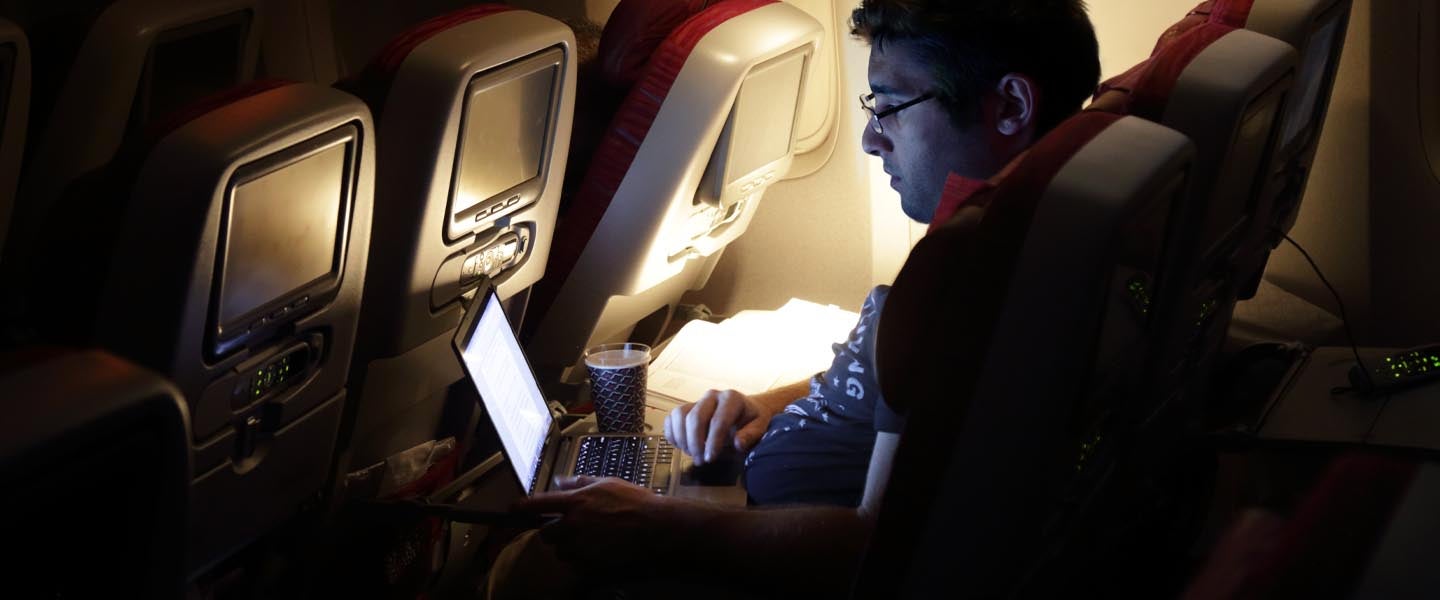We’ve all boarded a plane optimistically, laptop in hand, determined to Get Lots Done. “When I disembark,” we think, “I’ll have written that novel / solved that problem / perfected that plan. It’s an office in the sky, and I’m a 21st-century, world-travelling badass, a jet-set go-getter.”
Then we have four gin and tonics, watch three rom-coms, cry hysterically at all of them and pass out on a stranger’s shoulder, waking up 45 minutes later disoriented and confused, with a shirt covered in drool and a worryingly visible erection. It’s a dance as old as time.
But there are people who manage it — who trot happily down the steps and head for Arrivals having made actual tangible achievements six miles up in the air. To find out how, I spoke to a few high achievers (I really hope you see what I did there).
Key #1: Velcro and Extra Leg Room
Tom Barnes is a globetrotting photographer who has worked all over the world — he might shoot Metallica for Kerrang! one week, then do a personal project documenting survivors of acid attacks in Sudan the next. He’s also an airplane-seat-unfriendly 6-foot-6, a height he describes as “a curse,” yet manages to make the time he spends traveling work for him. “I always try to get a seat with extra leg room, even if I have to pay for it. It’s the only way I’ll get anything done,” Barnes explains. “I have velcro on the back of the hard drives I use and on top of my MacBook Pro lid so I can stick the two together — that way I don’t need to worry about wedging anything anywhere or dropping the hard drive and destroying the ports.”
“I use two-meter-long USB charging cables for my phone, as that means I can usually plug in wherever there’s a spare port and still have enough cable to move my phone about,” he continues. “I also travel with a Bluetooth graphics tablet so I can edit wirelessly. I also sometimes travel with an iPad and share my laptop screen to that, to make life a little easier on my neck and back as I can raise the screen up.”
Key #2: Forego the In-Flight Wi-Fi (When It Works At Least)
Haje Jan Kamps is a Silicon Valley pitch coach, helping startups from both Europe and the U.S. raise money from venture capitalists. Basically, he works on honing and perfecting pitches, both on a slide-by-slide and big-picture basis, in order to best aid companies in getting that sweet, sweet investment. “When I worked for a venture capital firm, I spent a lot of time flying between its two offices in Boston and San Francisco, and ended up doing a ton of work in the air,” he tells me. “My biggest tip would be to make sure that you have enough room to work. If time is more valuable than money, get a seat upgrade — nothing kills your productivity faster than having no elbow room.
“I ended up buying a Google Pixelbook to work on the go,” he adds. “It’s an extremely limited device, with no photo or video editing capabilities, but the battery just keeps going and going. If you’re just doing email, writing documents and such, the battery easily lasts longer than even the most harrowing of flights. I pair that with a hard-core USB-C battery pack, which adds another 12 hours of battery life.
“As for how to do the work, a lot of planes have Wi-Fi now, but I try to avoid connecting to it. Having a four- to five-hour block of uninterrupted time is a wonderful luxury. There’s been months where the only time I got any real head-down productive time was when I was on the plane.”
Key #3: Stack Up on Pen-and-Paper
Warren Ellis is a comic-book writer, bestselling novelist and showrunner of Netflix’s Castlevania. He’s written household-name characters for Marvel and DC as well as creating hugely-acclaimed series like Trees and Global Frequency. His current Batman miniseries, The Batman’s Grave, is awesome.
“I have a system,” he explains. “I put the seat display screen on to the route map thing, and leave it alone. I always travel with a dumb old MP3 player loaded with 20 GB of music and a really good set of wired earbuds that make a proper ear seal. I’m also carrying a laptop, a Kindle Paperwhite for reading and a paper notebook and pens. The trick for me is to not interact with anything I don’t have to interact with. If there’s a film I want to watch, I figure I have access to more comfortable places to watch than a bloody airplane.
“The notebook gives me options. The laptop has the weight of expectations, and it’s not always an expectation I’m going to feel like I can meet if I started out for Heathrow at the crack of dawn and I’m so tired I can barely feel my legs. Leaning back with the notebook and letting my mind wander still gets things done. And because I’m cut off from the world — and never, ever buy the plane Wi-Fi — and can think without distraction, sometimes that’s the most productive move of all.
“Given the limitations of my requirements, I don’t bug the cabin crew, and they only bug me when they think I need more booze, water or a strong cup of coffee before I land, which is good for all of us. It’s nice when the cabin crew are happy to see you off the plane because you made their lives a little easier, as opposed to them being happy to get you the hell away from them because you drank all the gin and tried to urinate through the cockpit lock while screaming that you have to be allowed to drown the ‘air sharks.’”

